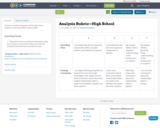
A rubric in student language used by high school students to self-assess their analysis skills.
- Subject:
- Applied Science
- Arts and Humanities
- English Language Arts
- History
- Mathematics
- Social Science
- Material Type:
- Assessment
- Date Added:
- 06/28/2017

A rubric in student language used by high school students to self-assess their analysis skills.

A rubric in student language used by middle school students to self-assess their analysis skills.

This course is a comprehensive introduction to control system synthesis in which the digital computer plays a major role, reinforced with hands-on laboratory experience. The course covers elements of real-time computer architecture; input-output interfaces and data converters; analysis and synthesis of sampled-data control systems using classical and modern (state-space) methods; analysis of trade-offs in control algorithms for computation speed and quantization effects. Laboratory projects emphasize practical digital servo interfacing and implementation problems with timing, noise, and nonlinear devices.

6.374 examines the device and circuit level optimization of digital building blocks. Topics covered include: MOS device models including Deep Sub-Micron effects; circuit design styles for logic, arithmetic and sequential blocks; estimation and minimization of energy consumption; interconnect models and parasitics; device sizing and logical effort; timing issues (clock skew and jitter) and active clock distribution techniques; memory architectures, circuits (sense amplifiers) and devices; testing of integrated circuits. The course employs extensive use of circuit layout and SPICE in design projects and software labs.

This course develops the fundamentals of feedback control using linear transfer function system models. Topics covered include analysis in time and frequency domains; design in the s-plane (root locus) and in the frequency domain (loop shaping); describing functions for stability of certain non-linear systems; extension to state variable systems and multivariable control with observers; discrete and digital hybrid systems and use of z-plane design. Students will complete an extended design case study. Students taking the graduate version (2.140) will attend the recitation sessions and complete additional assignments.

Analysis of AAC Implications for Unveiling Desideratum Communicative Therapies and Opportunities for Social Reciprocity and Improvement of Mental Welfare: A Critically Appraised Topic: This article brings awareness to implicaitons for further reseach analysis that can be conducted to expand knowledge of speech-language pathology intervention targeting social particpation for AAC users that projects beyond basic wants and needs, to promote more functional communiation.

This class analyzes complex biological processes from the molecular, cellular, extracellular, and organ levels of hierarchy. Emphasis is placed on the basic biochemical and biophysical principles that govern these processes. Examples of processes to be studied include chemotaxis, the fixation of nitrogen into organic biological molecules, growth factor and hormone mediated signaling cascades, and signaling cascades leading to cell death in response to DNA damage. In each case, the availability of a resource, or the presence of a stimulus, results in some biochemical pathways being turned on while others are turned off. The course examines the dynamic aspects of these processes and details how biochemical mechanistic themes impinge on molecular/cellular/tissue/organ-level functions. Chemical and quantitative views of the interplay of multiple pathways as biological networks are emphasized. Student work culminates in the preparation of a unique grant application in an area of biological networks.

This course focuses on computational and experimental analysis of biological systems across a hierarchy of scales, including genetic, molecular, cellular, and cell population levels. The two central themes of the course are modeling of complex dynamic systems and protein design and engineering. Topics include gene sequence analysis, molecular modeling, metabolic and gene regulation networks, signal transduction pathways and cell populations in tissues. Emphasis is placed on experimental methods, quantitative analysis, and computational modeling.

The goal of this course is to investigate with students backgrounds on some of the pivotal events that have shaped our understanding and approach to architecture. Emphasis of discussion will be primarily on buildings and works of individual architects. Canonical architects, buildings and movements that have exerted significant influences on the development of architecture will be studied in detail. We will visit some of these buildings for a first-hand look and to evaluate for ourselves their significance or lack thereof. As a final project, each student will analyze a building through drawings, text, bibliography and a physical model in a format ready for documentation and exhibition.

This exercise asks students to read excerpts about global migration and think about the factors that drive migration. Students will assess a series of statements to determine what factors encouraged or discouraged migration and map their analysis onto a map using + and all - symbols. The visual interpretation will help students better understand the push/pull factors involved with global migration movements of the 19th century.

This lab activity is designed for science students in an introductory climatology course. Upon successful completion of the activity, students will have demonstrated an ability to:
Independently navigate and download climate data from online data libraries.
Work with different file types (NetCDF and CSV).
Write appropriate MATLAB code to read and manipulate climate data, and create plots (time series and maps) as instructed.
Extract meaningful information from large 3-dimensional datasets.
Understand and apply fundamental climatology concepts, such as:
Climate statistics (temporal and spatial mean and anomaly; trends; baselines)
Ice-albedo feedback resulting in disproportionate sensitivity to climate change in polar regions
(Note: this resource was added to OER Commons as part of a batch upload of over 2,200 records. If you notice an issue with the quality of the metadata, please let us know by using the 'report' button and we will flag it for consideration.)

An analysis of historical structures is presented themed sections based around construction materials. Structures from all periods of history are analyzed. The goal of the class is to provide an understanding of the preservation of historic structures for all students.

In this activity students examine groundwater flow path based on hydraulic head data/ potentiometric surface and spatial variation of groundwater chemistry. Students analyze the data using AquaChem and Phreeqc which is integrated with AquaChem
(Note: this resource was added to OER Commons as part of a batch upload of over 2,200 records. If you notice an issue with the quality of the metadata, please let us know by using the 'report' button and we will flag it for consideration.)

This document presents the results of the Erasmus+ "InterMedia Project," focusing on the exploration of multimedia and interactivity in the context of education and learning. The first section provides an overview of multimedia, including its definition, origins, evolution, and significance in daily life. The following section delves into the concept of interactivity, defining it and highlighting its different types and importance. The document then explores the added value of multimedia and interactive learning content for learners, training providers, and adult education organizations. It emphasizes the benefits and considerations associated with different age groups of adults. The subsequent section analyses various tools used in the project, such as Animaker, Canva, Exe-learning, HTML Validator, Padlet, the H5P Framework, ThingLink, Powtoon, and W3Schools. Lastly, the document provides information about the project partners, including AJITER, EUPHORIANET, BRAINLOG, and EUROPÄISCHE BILDUNGSINITIATIVE EBI/EIE.
Overall, the Erasmus+ "InterMedia Project" offers valuable insights into the potential of multimedia and interactivity in the field of education.
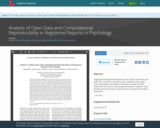
Ongoing technological developments have made it easier than ever before for scientists to share their data, materials, and analysis code. Sharing data and analysis code makes it easier for other researchers to re-use or check published research. These benefits will only emerge if researchers can reproduce the analysis reported in published articles, and if data is annotated well enough so that it is clear what all variables mean. Because most researchers have not been trained in computational reproducibility, it is important to evaluate current practices to identify practices that can be improved. We examined data and code sharing, as well as computational reproducibility of the main results, without contacting the original authors, for Registered Reports published in the psychological literature between 2014 and 2018. Of the 62 articles that met our inclusion criteria, data was available for 40 articles, and analysis scripts for 37 articles. For the 35 articles that shared both data and code and performed analyses in SPSS, R, Python, MATLAB, or JASP, we could run the scripts for 31 articles, and reproduce the main results for 20 articles. Although the articles that shared both data and code (35 out of 62, or 56%) and articles that could be computationally reproduced (20 out of 35, or 57%) was relatively high compared to other studies, there is clear room for improvement. We provide practical recommendations based on our observations, and link to examples of good research practices in the papers we reproduced.
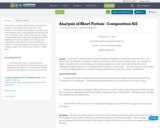
In this lesson, students will learn how to analyze and decipher crucial details in the short story “The Women” by Tom Barbash in response to questions put forth to them in their writing prompt. This exercise will help to strengthen their critical thinking and reading comprehension skills, while their writing skills will be challenged through a response to a writing prompt resulting in a formal essay. The lesson will also ask students to recall and integrate ideas from an earlier reading entitled “How to Read Like a Writer” by Mike Bunn.
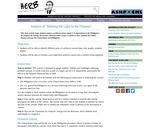
This short activity helps students analyze a political cartoon about U.S. imperialism in the Philippines. To complete the activity, the teacher will need either a map or a globe to show students the relative distance between the United States and Philippines.
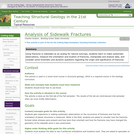
Sidewalks provide a good analog for the study of fractures when outcrops are not available. This exercise is taught as the first lab of the semester in an undergraduate structural geology course. Students learn to make systematic observations, measure the orientation and location of fractures, manipulate and analyze data, and consider some kinematic and dynamic questions regarding the origin and significance of fractures. Their experiences are also used later in the course to reinforce key concepts of brittle deformation. Done as a group project, it emphasizes the importance of group work and encourages students to propose and defend their ideas.
(Note: this resource was added to OER Commons as part of a batch upload of over 2,200 records. If you notice an issue with the quality of the metadata, please let us know by using the 'report' button and we will flag it for consideration.)
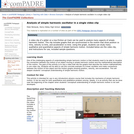
One video clip, with embedded graphs, can be used to help students understand the mathematical relationships that describe simple harmonic motion.
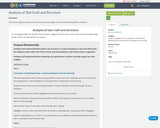
This lesson explores authors craft and sturcture through and event that directly effects students.